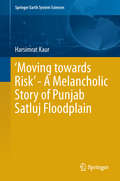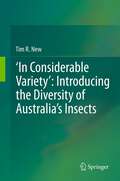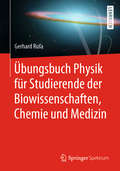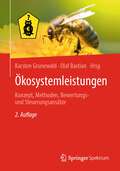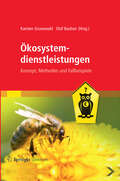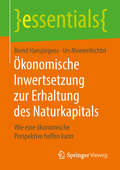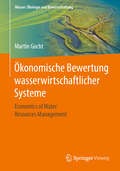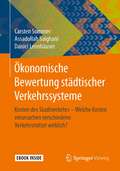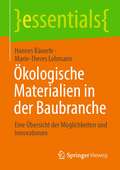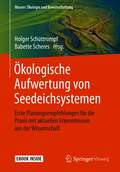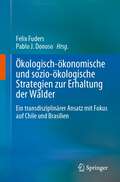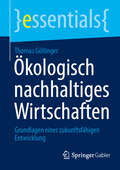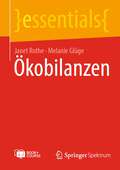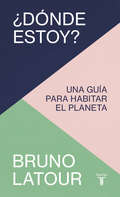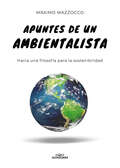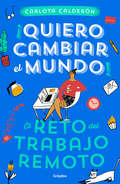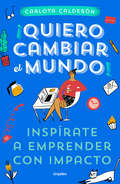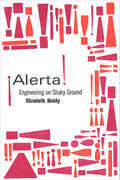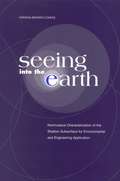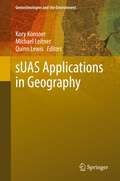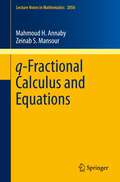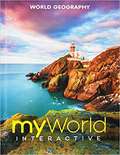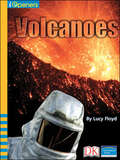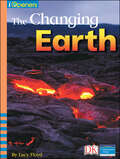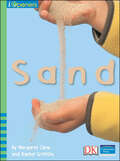- Table View
- List View
‘Moving towards Risk’ - A Melancholic Story of Punjab Satluj Floodplain (Springer Earth System Sciences)
by Harsimrat KaurThis book explains the tragic tale of the Satluj floodplain since its inception. As a landscape this floodplain entity evolves and sets a niche to distinctive natural and cultural aspects. The historical reconstruction of the landscape transformation depicts the excessive human encroachment and development activities which leads to more than fifty percent of landscape transformation. Data set layers were generated in a geospatial environment, with the use of multiscale and multitemporal satellite imageries, empirical field verification, and ancillary data input. An integrated landscape model was hence formed in order to identify the causal links between natural and cultural aspects.The author shows a landscape transformation matrix and change detection maps to explain the spatial trends and patterns of land use and land cover change. Pixel wise land use and land cover gain-loss algorithm were identified and measured for a selected time period. Changing spatial pattern of land cover to land use ratio are explained with underlying local to regional level causes. The author thoroughly explains the satellite image interpretation and related methodology. This book provides the detailed transition journey of landscape conversion from resource rich natural entity to a human dominated ‘hazardscape’. It also explains how the expansion of population and related activities in the close vicinity of an active floodplain accentuates the problem of flood risks and how it affects the human and livestock life and creates economic loss. The author maps and explains the vector and magnitude of increased human pressure on the landscape and its adverse ecological implications, and describes issues with reference to the hazard status of the Punjab Satluj floodplain, including increased flood risk, increased pressure on agricultural land and depletion of resources, loss of biodiversity, qualitative and quantitative loss to surface and sub-surface water, and soil degradation (soil erosion, waterlogging and soil loss).Recommendations are provided with a detailed provision of potential applications with the underlying agenda of further conversion of this ecologically highly vulnerable flood prone ‘hazardscape’ to a Green Habitat. This book consist of two major themes: land use/land cover change and floodplain. The author answers all the geographical questions (what, where, when, why and how) related with both themes and provides an outlook to potential future prospects. The book is targeted at stakeholders, students, researchers and policy makers to optimize their interest and to guide them towards a positive charge in sustainable resource management through suitable and best possible sustainable utilization of landscape.
‘In Considerable Variety’: Introducing The Diversity Of Australia's Insects
by Tim R. NewThe book introduces basic entomology, emphasising perspectives on insect diversity important in conservation assessment and setting priorities for management, as a foundation for managers and others without entomological training or background. It bridges the gap between photographic essays on insect identification and more technical texts, to illustrate and discuss many aspects of taxonomic, ecological and evolutionary diversity in the Australian insect fauna, and its impacts in human life, through outlines of many aspects of insect natural history.
Übungsbuch Physik für Studierende der Biowissenschaften, Chemie und Medizin
by Gerhard RufaDieses Übungsbuch enthält zahlreiche Aufgaben zum Inhalt einer Einführungsvorlesung Physik. Mithilfe von ausführlichen Lösungen und Erklärungen lernen und üben Studierende die Anwendung physikalischer Rechenmethoden und die hierfür erforderliche Mathematik. Vor allem in Kombination mit dem Lehrbuch Physik für Studierende der Biowissenschaften, Chemie und Medizin bildet es eine ideale Basis für die Klausurvorbereitung und weiterführende Vorlesungen.Der erste Teil des Buches bietet Übungsserien mit Aufgaben, die entsprechend dem Inhalt typischer Physikvorlesungen strukturiert sind und dabei Themen von der klassischen Mechanik bis hin zur Atom- und Quantenphysik abdecken. Jede Übungsserie besteht aus einem Verständnisteil und einem Übungsteil, der durch anwendungsorientierte Aufgaben aus Biowissenschaften, Chemie und Medizin ergänzt wird.Das Gelernte kann dann anhand des zweiten Teils überprüft werden, der aus verschiedenen Testserien besteht: Hier sind gemischte Aufgaben aus den jeweiligen Inhalten der zwei Semester enthalten, wie sie auch in Physikklausuren zu finden sind.
Ökosystemleistungen: Konzept, Methoden, Bewertungs- und Steuerungsansätze
by Karsten Grunewald Olaf BastianDie Natur liefert uns viele Leistungen gratis: So bildet sich Grundwasser neu, bleiben Böden fruchtbar, erzeugt die Photosynthese pflanzliche Biomasse. Wir Menschen ziehen aus diesen „Ökosystemdienstleistungen“ (kurz: ÖSD) vielfältigen Nutzen, sei es für die Ernährung, die Versorgung mit Wasser, für die Erholung oder den Schutz vor Naturgefahren. Große internationale Studien wie das Millennium Ecosystem Assessment haben sich eingehend mit den weltweit von Ökosystemen bereitgestellten Leistungen befasst und eindringlich auf die Folgen hingewiesen, die mit deren Verminderung oder Verlust einhergehen.Dieses hochaktuelle Thema wird von Wissenschaftlern ganz unterschiedlicher Disziplinen bearbeitet. Herangehensweisen, Begriffs- und Methodenverständnis sind entsprechend vielfältig. Was ist zum Beispiel mit Leistungsfähigkeit der Natur oder mit Naturkapital gemeint? Welche Werte der Natur sind besonders wichtig, wie sind sie verteilt und wie beurteilt bzw. vermittelt man sie? Können alle Ökosystemdienstleistungen einzeln und als Summe quantifiziert oder gar monetarisiert werden? Was ist zu tun, damit uns die vielfältigen Leistungen der Natur auch zukünftig zur Verfügung stehen?Das vorliegende Buch erläutert das vielschichtige Konzept der Ökosystemdienstleistungen, zeigt einen methodischen Rahmen zu ihrer Analyse und Bewertung auf und diskutiert Fallbeispiele, vor allem aus Deutschland.Angesprochen sind Wissenschaftler wie Praktiker aus dem behördlichen, ehrenamtlichen und freiberuflichen Bereich, vor allem im Umwelt- und Naturschutz sowie der Regional- und Flächennutzungsplanung, Fachleute aus der Wirtschaft, auf politischen Bühnen Tätige, Studierende sowie alle, die sich für ökologische, ökonomische, ethische und umweltpolitische Grundsatzfragen sowie Belange von Ökosystemen und Landschaften interessieren.Für die 2. Auflage wurden alle Kapitel aktuell überarbeitet, die Methoden und der Bezug zu Ökosystemtypen stärker betont.
Ökosystemdienstleistungen
by Karsten Grunewald Olaf BastianDie Natur liefert uns viele Leistungen gratis: So bildet sich Grundwasser neu, bleiben Böden fruchtbar, erzeugt die Photosynthese pflanzliche Biomasse. Wir Menschen ziehen aus diesen "Ökosystemdienstleistungen" (kurz: ÖSD) vielfältigen Nutzen, sei es für die Ernährung, die Versorgung mit Wasser, für die Erholung oder den Schutz vor Naturgefahren. Große internationale Studien wie das Millennium Ecosystem Assessment haben sich eingehend mit den weltweit von Ökosystemen bereitgestellten Leistungen befasst und eindringlich auf die Folgen hingewiesen, die mit deren Verminderung oder Verlust einhergehen. Dieses hochaktuelle Thema wird von Wissenschaftlern ganz unterschiedlicher Disziplinen bearbeitet. Herangehensweisen, Begriffs- und Methodenverständnis sind entsprechend vielfältig. Was ist zum Beispiel mit Leistungsfähigkeit der Natur oder mit Naturkapital gemeint? Welche Werte der Natur sind besonders wichtig, wie sind sie verteilt und wie beurteilt bzw. vermittelt man sie? Können alle Ökosystemdienstleistungen einzeln und als Summe quantifiziert oder gar monetarisiert werden? Was ist zu tun, damit uns die vielfältigen Leistungen der Natur auch zukünftig zur Verfügung stehen? Das vorliegende Buch erläutert das vielschichtige Konzept der Ökosystemdienstleistungen, zeigt einen methodischen Rahmen zu ihrer Analyse und Bewertung auf und diskutiert Fallbeispiele, vor allem aus Deutschland. Angesprochen sind Wissenschaftler wie Praktiker aus dem behördlichen, ehrenamtlichen und freiberuflichen Bereich, vor allem im Umwelt- und Naturschutz sowie der Regional- und Flächennutzungsplanung, Fachleute aus der Wirtschaft, auf politischen Bühnen Tätige, Studierende sowie alle, die sich für ökologische, ökonomische, ethische und umweltpolitische Grundsatzfragen sowie Belange von Ökosystemen und Landschaften interessieren.
Ökonomische Inwertsetzung zur Erhaltung des Naturkapitals: Wie eine ökonomische Perspektive helfen kann (essentials)
by Bernd Hansjürgens Urs MoesenfechtelIn diesem essential beschreiben Bernd Hansjürgens und Urs Moesenfechtel die Dringlichkeit eines Perspektivenwechsels bei unserem Umgang mit der Natur. Sie schlagen dazu eine ökonomische Inwertsetzung von Ökosystemleistungen vor und zeigen auf, welche Handlungsmöglichkeiten dieser Ansatz dem Naturschutz eröffnet.
Ökonomische Bewertung wasserwirtschaftlicher Systeme: Economics of Water Resources Management (Wasser: Ökologie und Bewirtschaftung)
by Martin GochtDieses Buch vermittelt die notwendigen volkswirtschaftlichen und privatwirtschaftlichen Grundlagen zur Beurteilung wasserwirtschaftlicher Projekte. Es vermittelt die unterschiedlichen Perspektive, ohne deren Berücksichtigung die Ergebnisse leicht falsch verstanden werden. This book provides the necessary fundamentals for assessing water management projects in public economics and in the private-sector. It conveys the different perspectives to the readers, that are needed to prevent missinterpretation of results.
Ökonomische Bewertung städtischer Verkehrssysteme: Kosten des Stadtverkehrs – Welche Kosten verursachen verschiedene Verkehrsmittel wirklich?
by Carsten Sommer Assadollah Saighani Daniel LeonhäuserDas Buch unterstützt bei der Anwendung der Verfahren für die Planungspraxis zur stätischen (urbanen) Verkehrssystemen und gibt Anleitung für die Interpretation der Ergebnisse. Neben direkten finanziellen Wirkungen verursacht städtischer Verkehr eine Reihe externer Effekte (u.a. Unfall-, Umwelt- und Klimakosten), die jedoch nicht von den Verkehrsteilnehmern, sondern von Dritten getragen werden. Der erste Schritt zur Beantwortung zahlreicher Fragen der Verkehrspolitik, der strategischen Verkehrsplanung und der Verkehrswissenschaft stellt eine Kostentransparenz im Verkehr dar. Für eine nachhaltige und effiziente Verkehrs- und Infrastrukturplanung sind daher Erkenntnisse über die Kosten der unterschiedlichen Verkehrsarten von hoher Bedeutung. Das vorliegende Buch stellt ein neues Bewertungsverfahren vor, das einen vollständigen und verkehrsmittelübergreifenden Überblick über die ökonomischen Wirkungen städtischen Verkehrs ermöglicht. Unter anderem sind die erforderlichen Eingangsgrößen, Annahmen und Berechnungsvorschriften beschrieben und mit Hinweisen für die Praxis sowie Beispielrechnungen und schematischen Darstellungen ergänzt.
Ökologische Materialien in der Baubranche: Eine Übersicht der Möglichkeiten und Innovationen (essentials)
by Hannes Bäuerle Marie-Theres LohmannDieses essential zeigt wirksame und innovative Materialbeispiele, die maßgeblich für ein besseres Raumklima eigesetzt werden können und erklärt gleichzeitig, warum ein Umdenken in Richtung Nachhaltigkeit in der Baubranche wichtig ist. Einleitend gibt es einen kurzen Einblick in die Thematik rund um Ökologie und Nachhaltigkeit. Beispielhafte Materialien unterschiedlicher Bereiche und Möglichkeiten der Entsorgung werden aufgeführt. Zudem wird eine denkbare Zukunft im Baubereich fokussiert. Somit bietet das essential einen informativen Rundumblick in die Welt des nachhaltigen Bauens.
Ökologische Aufwertung von Seedeichsystemen: Erste Planungsempfehlungen für die Praxis mit aktuellen Erkenntnissen aus der Wissenschaft (Wasser: Ökologie und Bewirtschaftung)
by Holger Schüttrumpf Babette ScheresSeedeiche stellen ein wichtiges Element des deutschen Küstenschutzes dar. Bei der Planung und Konstruktion von Seedeichen werden die hydraulischen Belastungen (d. h. Wasserstände und Wellenparameter) sowie die geotechnischen (z. B. Bodenparameter) und lokalen Randbedingungen (z. B. Platzverhältnisse) einbezogen. Umwelt- und naturschutzfachliche Aspekte werden bislang lediglich durch Nutzung lokaler Ressourcen und Minimalisierung des Ressourcenverbrauchs sowie Ausgleichsmaßnahmen berücksichtigt. Möglichkeiten zur ökologischen Aufwertung des Seedeichsystems stellen (i) natürliche oder naturbasierte Lösungen im Vorland und (ii) eine angepasste Gestaltung des Deichbauwerks selbst dar. Das geplante Werk stellt auf Grundlage aktueller wissenschaftlicher Erkenntnisse erste Empfehlungen für Bemessung, Konstruktion, Monitoring und Unterhaltung ökologisch aufgewerteter Seedeiche zusammen, die eine Steigerung des ökosystemaren Werts unter gleichzeitiger Beachtung der Deichsicherheit ermöglichen.
Ökologisch-ökonomische und sozio-ökologische Strategien zur Erhaltung der Wälder: Ein transdisziplinärer Ansatz mit Fokus auf Chile und Brasilien
by Felix Fuders Pablo J. DonosoIn diesem Buch werden Strategien zur Verbesserung der Widerstandsfähigkeit und des Schutzes der gemäßigten Wälder in Südamerika vorgeschlagen, damit diese Wälder auf nachhaltige Weise Ökosystemleistungen erbringen können. Als solches trägt es zum Entwurf eines widerstandsfähigen Mensch-Wald-Modells bei, das die Multikulturalität lokaler Gemeinschaften berücksichtigt und in vielen Fällen Aspekte der ökologischen Ökonomie, der Entwicklungsökonomie und der territorialen Entwicklungsplanung einbezieht, die mit indigenen Völkern oder „First Nations“ zu tun haben. Darüber hinaus werden Vorschläge für öffentliche und territoriale Politiken unterbreitet, die den Erhaltungszustand der einheimischen Wälder und Waldökosysteme verbessern, und zwar auf der Grundlage einer kritischen Analyse der wirtschaftlichen Faktoren, die zur Degradierung der Waldökosysteme im heutigen Südamerika führen.Dieses Buch wurde von Mitgliedern des Transdisziplinären Forschungszentrums für soziale und ökologische Strategien zur nachhaltigen Waldbewirtschaftung in Südamerika an der Universidad Austral de Chile konzipiert. Es enthält Beiträge von renommierten Forschern aus der ganzen Welt, die die Bereiche Wirtschaft, Ökologie, Biologie, Anthropologie, Soziologie und Statistik miteinander verbinden. Es handelt sich jedoch nicht einfach um eine Sammlung von Arbeiten, die von Autoren aus verschiedenen Disziplinen verfasst wurden. Vielmehr erhebt jedes Kapitel den Anspruch, in sich selbst transdisziplinär zu sein. Dieser Ansatz macht das Buch zu einem einzigartigen Beitrag zur Verbesserung sozialer, betriebswirtschaftlicher und politischer Ansätze in der Waldbewirtschaftung, die dazu beitragen, die Ökosystemleistungen des Waldes zu schützen und nachhaltiger zu gestalten. Dies wiederum kommt den lokalen Gemeinschaften und der Gesellschaft als Ganzes zugute, indem die negativen externen Effekte der Forstwirtschaft verringert und die Zukunftschancen verbessert werden.
Ökologisch nachhaltiges Wirtschaften: Grundlagen einer zukunftsfähigen Entwicklung (essentials)
by Thomas GöllingerIn diesem essential werden die wichtigsten Grundlagen des ökologisch nachhaltigen Wirtschaftens erläutert. Nach einer kompakten Klärung der verschiedenen Verständnisse und Bedeutungen von „Nachhaltigkeit“ und „Nachhaltiger Entwicklung“ erfolgt eine Darlegung der prinzipiellen Problematik im Kontext von Ökologie und Ökonomie. Eine Erörterung der diversen Handlungsfelder und Strategieoptionen zeigt die vielfältigen Möglichkeiten bezüglich Effizienz-, Konsistenz- und Suffizienz-Innovationen auf. Schließlich erfolgt ein Blick auf die aktuellen Herausforderungen des Nachhaltigkeitsmanagements.
Ökobilanzen (essentials)
by Janet Rothe Melanie GlügeSeit der Industrialisierung im 18. Jahrhundert haben sich Ansprüche an Produkte und ihre Produktionsweise geändert. Kunden sind sich im 21. Jahrhundert der Tragweite ihrer Kaufentscheidung bewusster, sodass Hintergrundwissen zu Produktionsbedingungen und Lieferketten eine immer wichtigere Rolle spielen. Mit Hilfe von Produkt-Ökobilanzen ist eine Ermittlung von umweltschonenderen Produktionsverfahren möglich. Ziel dieses Buches ist es, Ihnen diese Ermittlungsverfahren einfach und praxisnah zu erklären. Wie erstellt man eine Ökobilanz? Anhand von realistischen Beispielen wird gezeigt, wie eine Ökobilanz aufgebaut ist, wie bilanziert und berechnet wird.
¿Dónde estoy?: Una guía para habitar el planeta
by Bruno LatourUNA PODEROSA INVITACIÓN A DESCONFINARNOS DE CIERTAS IDEAS ARRAIGADAS. «El filósofo más famoso e incomprendido de Francia, ampliamente reconocido como uno de los pensadores contemporáneos más inventivos e influyentes del mundo.»The New York Times «Hemos perdido la antigua libertad, pero ha sido para ganar otra.» En este ensayo en forma de cuento, inspirado en La metamorfosis de Kafka, Bruno Latour, uno de los pensadores más originales e influyentes del mundo, nos invita a desconfinarnos de ciertas ideas arraigadas de la modernidad, como las de «crecimiento económico», «progreso» o «dominio de la naturaleza». No hay duda de que la crisis le ha dado la razón de manera patente en muchas de las teorías que ha defendido a lo largo de los años. En este libro da cuenta de ello elegantemente. Tras la terrible experiencia del confinamiento, tanto los estados como los individuos buscan la manera de regresar lo más rápido posible al mundo anterior. Pero hay lecciones que aprender de esta experiencia, al menos en beneficio de aquellos a quienes podría llamarse terrestres («cualquiera que acepte vivir en una zona crítica y contribuir a su habitabilidad»), conscientes de que la crisis sanitaria está inmersa en otra crisis mucho más grave, la impuesta por el Nuevo Régimen Climático. El confinamiento nos ha ofrecido una gran oportunidad que debemos aprovechar: la de comprender finalmente dónde vivimos y en qué Tierra podremos desenvolvernos, a falta de la antigua. Tras un aterrizaje sin duda violento, los terrestres deben explorar el suelo donde ahora vivirán y redescubrir el gusto por la libertad y la emancipación, pero en un lugar diferente. Ese es el objeto de este ensayo, que consta de breves capítulos, cada uno de los cuales explora una posible figura de esta metafísica del desconfinamiento a la que nos obliga la extraña época en que vivimos. La crítica ha dicho...«El filósofo más famoso e incomprendido de Francia, ampliamente reconocido como uno de los pensadores contemporáneos más originales e influyentes.»The New York Times «Uno de los pensadores más interesantes de la escena intelectual mundial. Sabe cómo llamar nuestra atención sobre la complejidad de los problemas, manteniendo una claridad expositiva fuera de lo común.»La Stampa «Latour adopta el tono de un cuento filosófico lúdico y erudito a la vez. Lo que escribe Latour nos concierne a todos los seres humanos.»Slate Magazine «Uno de los autores más comentados y citados del mundo. Inspira a generaciones de investigadores en filosofía y ciencias sociales. ¿Dónde estoy?,un ensayo más narrativo, es perfecto para iniciarse en su obra.»Philosophie Magazine «Una invitación a inventar nuevas maneras de vivir.»Le Monde
¡Tierra a la vista!: Hacia una filosofía para la sostenibilidad
by Máximo MazzoccoUna de las voces más relevantes del ambientalismo joven argentino comparte su visión acerca de cómo transformar el mundo que habitamos y revertir la crisis planetaria. El mundo está cambiando (demasiado rápido). Lo sentimos, lo vemos, lo caminamos. "Somos lo último de lo viejo y lo primero de lo nuevo", cuenta el recuerdo del porvenir. "La jugada es ahora, no después", insiste la crisis climática y ecológica. ¿Qué dirán sobre esta época en el futuro? ¿La juzgarán como egoísta, individualista, genocida, ecocida, antropocentrista e incauta? ¿O podremos virar el barco hacia algo más romántico y esperanzador? ¿Será "el siglo donde la humanidad recapituló, puso al alma colectiva en puntas de pie y se despertó a tiempo"? ¿O será lo contrario? Buscamos materializar la ilusión de la sostenibilidad en un planeta que, con o sin nosotros, seguirá girando. Por un lado, no tenemos idea de qué hay detrás de ese horizonte, ya que está precedido por lo misterioso, incierto y desconocido. Por otro, sabemos que debemos ir en esa dirección, hacia el bien común. Si la meta es un mundo pacífico, justo, educado, sin pobreza, sin hambre, con igualdad de oportunidades y de género, lleno de vida submarina y ecosistemas terrestres sanos, solo nos queda armar el molde y colocar los ladrillos necesarios. Del otro lado nos están esperando.
¡Quiero cambiar el mundo!: El reto del trabajo remoto
by Carlota CalderónNo dejes que la distancia te impida crear equipos creativos y emprendedores capaces de transformar el mundo en el que vivimos. Sucedió lo que parecía imposible. Un día, debido a un virus, el planeta entero detuvo su frenética actividad, y las medidas de encierro y distanciamiento social transformaron nuestras vidas para siempre. Son muchos los escenarios que justifican nuestros miedos, pero todavía queda un pequeño espacio para la esperanza: ante nuestros ojos surgen nuevas estructuras empresariales y de trabajo, más colaborativas, más digitales y más humanas. Estos retos nos empujan a ser más creativos y también más emprendedores. Quizás ésta sea la oportunidad perfecta para practicar las nuevas habilidades que nos ayudarán en la transición hacia una economía más responsable. Quiero invitarte a descubrirlas conmigo. Soy Carlota Calderón, periodista, comunicadora y emprendedora social, y estoy convencida de que es posible crear una empresa capaz obtener ingresos y generar un impacto social positivo al mismo tiempo. Este ebook es un pequeño vistazo a las lecciones que descubriremos con Itzel, una joven emprendedora interesada en solucionar el desabasto de agua en comunidades desfavorecidas y quien, al igual que el resto de nosotros, deberá adaptarse a la nueva realidad de trabajar desde casa sin abandonar su deseo de ofrecer soluciones creativas para su comunidad. Descubre cuáles son esas habilidades, ponlas en práctica y aprende más a partir de la experiencia de un verdadero emprendedor social, Juan Pablo Escobar Luque, fundador de Cívica Digital, quien nos comparte sus secretos para trabajar a distancia con equipos creativos.
¡Quiero cambiar el mundo!
by Carlota Calderón ArrecheaNo dejes que la distancia te impida crear equipos creativos y emprendedores capaces de transformar el mundo en el que vivimos. Sucedió lo que parecía imposible. Un día, debido a un virus, el planeta entero detuvo su frenética actividad, y las medidas de encierro y distanciamiento social transformaron nuestras vidas para siempre. Son muchos los escenarios que justifican nuestros miedos, pero todavía queda un pequeño espacio para la esperanza: ante nuestros ojos surgen nuevas estructuras empresariales y de trabajo, más colaborativas, más digitales y más humanas. Estos retos nos empujan a ser más creativos y también más emprendedores. Quizás ésta sea la oportunidad perfecta para practicar las nuevas habilidades que nos ayudarán en la transición hacia una economía más responsable. Quiero invitarte a descubrirlas conmigo. Soy Carlota Calderón, periodista, comunicadora y emprendedora social, y estoy convencida de que es posible crear una empresa capaz obtener ingresos y generar un impacto social positivo al mismo tiempo. Este ebook es un pequeño vistazo a las lecciones que descubriremos con Itzel, una joven emprendedora interesada en solucionar el desabasto de agua en comunidades desfavorecidas y quien, al igual que el resto de nosotros, deberá adaptarse a la nueva realidad de trabajar desde casa sin abandonar su deseo de ofrecer soluciones creativas para su comunidad. Descubre cuáles son esas habilidades, ponlas en práctica y aprende más a partir de la experiencia de un verdadero emprendedor social, Juan Pablo Escobar Luque, fundador de Cívica Digital, quien nos comparte sus secretos para trabajar a distancia con equipos creativos.
¡Alerta!: Engineering on Shaky Ground
by Elizabeth ReddyA lively account of a controversial technology developed to mitigate earthquake risk and change how we live with threatening environments.The Sistema de Alerta Sísmica Mexicano is the world&’s oldest public earthquake early warning system. Given the unpredictability of earthquakes, the technology was designed to give the people of Mexico City more than a minute to prepare before the next big quake hits. How does this kind of environmental monitoring technology get built in the first place? How does its life-saving promise align with reality? And who shapes modern risk mitigation? In ¡Alerta!, Elizabeth Reddy surveys this innovation to shed light on what it means to imagine a world where sirens could sound out an ¡alerta sísmica! at any moment—and what it would be like to live in such a world.Proponents of earthquake early warnings have long held that the technology can save lives and limit economic losses. Drawing on ethnographic fieldwork and archival data, Reddy conducts a thorough, qualitative analysis of these claims and considers the requirements and uses of the alert system. She embeds her study in a rich narrative of the engineers who designed the system in conjunction with contingent political and environmental conditions. The result demonstrates how addressing earthquake dangers is no small task: it means trying to change relationships between the environment, society, and technology. Doing so, she critiques universalist and techno-centric approaches to hazard risk mitigation and celebrates the potential of contextually appropriate and broadly supported efforts.¡Alerta! takes readers on a vivid journey into the world of Mexican earthquake risk mitigation, with critical insights for anthropologists and science and technology studies scholars, as well as specialists in the geosciences, engineering, and emergency management.
seeing into the earth: Noninvasive Characterization of the Shallow Subsurface for Environmental and Engineering Applications
by Board on Earth Sciences ResourcesJust below our feet is an environment that supports our infrastructure, yields water, provides for agriculture, and receives our waste. Our capacity to describe, or characterize, this environment is crucial to the solution of many resource, environmental, and engineering problems. And just as medical imaging technologies have reduced the need for exploratory surgeries, a variety of technologies hold the promise for rapid, relatively inexpensive noninvasive characterization of the Earth's subsurface.Seeing into the Earth examines why noninvasive characterization is important and how improved methods can be developed and disseminated. Looking at the issues from both the commercial and public perspectives, the volume makes recommendations for linking characterization and cost savings, closing the gap between the state of science and the state of the practice, and helping practitioners make the best use of the best methods. The book provides background on: The role of noninvasive subsurface characterization in contaminant cleanup, resource management, civil engineering, and other areas. The physical, chemical, biological, and geological properties that are characterized. Methods of characterization and prospects for technological improvement.Certain to be important for earth scientists and engineers alike, this book is also accessible to interested lay readers.
sUAS Applications in Geography (Geotechnologies and the Environment #24)
by Michael Leitner Quinn Lewis Kory KonsoerThe use of small unoccupied aerial systems (sUAS) for acquiring close-range remotely sensed data has substantially increased in the past 5 years. A primary focus of early research was on physical systems and photogrammetric techniques. However, as sUAS technology continues to improve and more sophisticated payloads are utilized, such as lidar and multispectral cameras, applications have expanded to nearly all subdisciplines within Geography. This edited volume is intended to showcase the various ways in which sUAS are used in geographic research, including geomorphology, environmental and hazard monitoring, biogeography, and urban and sociocultural geography.
q-Fractional Calculus and Equations
by Zeinab S. Mansour Mahmoud H. AnnabyThis nine-chapter monograph introduces a rigorous investigation of q-difference operators in standard and fractional settings. It starts with elementary calculus of q-differences and integration of Jackson's type before turning to q-difference equations. The existence and uniqueness theorems are derived using successive approximations, leading to systems of equations with retarded arguments. Regular q-Sturm-Liouville theory is also introduced; Green's function is constructed and the eigenfunction expansion theorem is given. The monograph also discusses some integral equations of Volterra and Abel type, as introductory material for the study of fractional q-calculi. Hence fractional q-calculi of the types Riemann-Liouville; Grünwald-Letnikov; Caputo; Erdélyi-Kober and Weyl are defined analytically. Fractional q-Leibniz rules with applications in q-series are also obtained with rigorous proofs of the formal results of Al-Salam-Verma, which remained unproved for decades. In working towards the investigation of q-fractional difference equations; families of q-Mittag-Leffler functions are defined and their properties are investigated, especially the q-Mellin-Barnes integral and Hankel contour integral representation of the q-Mittag-Leffler functions under consideration, the distribution, asymptotic and reality of their zeros, establishing q-counterparts of Wiman's results. Fractional q-difference equations are studied; existence and uniqueness theorems are given and classes of Cauchy-type problems are completely solved in terms of families of q-Mittag-Leffler functions. Among many q-analogs of classical results and concepts, q-Laplace, q-Mellin and q2-Fourier transforms are studied and their applications are investigated.
myWorld Interactive Middle Grades Geography 2019 National Survey (Student Edition Grade 6/8)
by Prentice-Hall StaffmyWorld Interactive Middle Grades Geography 2019 National Survey (Student Edition Grade 6/8)
iOpener: Volcanoes (iOpeners)
by Lucy FloydThis book explains everything about volcanoes, from the life of a volcano, to plate tectonics, to lava formations, to nearby civilizations. Fact boxes and diagrams showcase amazing details, while a glossary, index, and discussion questions aid in reading comprehension.Grade: 4Subject: Earth ScienceGenre: Informational TextComprehension Skill/Strategy: Comprehend/Take NotesDiagnostic Reading Assessment (DRA/EDL): 40Guided Reading Level: RLexile Level: 800LDK's iOpeners equip K-6 students with the skills and strategies they need to access and comprehend nonfiction so that they are not only learning to read but reading to learn. The combination of high-interest content and eye-popping photography of iOpeners brings science and social studies topics to life, raises student achievement in reading, and boosts standardized test scores.
iOpener: The Changing Earth (iOpeners)
by Lucy FloydThis 550-word book covers all sorts of information about tectonic plates, volcanoes, and highlands. Beautiful photography is accompanied by key diagrams and a glossary that explain the topic in detail. Discussion questions aid in comprehension of the subject matter.Grade: 2Subject: Earth ScienceGenre: Informational TextComprehension Skill/Strategy: Identify Cause and EffectDiagnostic Reading Assessment (DRA/EDL): 30Guided Reading Level: NLexile Level: N/ADK's iOpeners equip K-6 students with the skills and strategies they need to access and comprehend nonfiction so that they are not only learning to read but reading to learn. The combination of high-interest content and eye-popping photography of iOpeners brings science and social studies topics to life, raises student achievement in reading, and boosts standardized test scores.
iOpener: Sand (iOpeners)
by Rachel Griffiths Margaret ClyneThis 49-word book for young readers will teach all about sand, how it's made, and where it's found. Every page contains big, beautiful photographs, and there are discussion questions to aid in reading comprehension.Grade: 1Subject: Earth ScienceGenre: Informational TextComprehension Skill/Strategy: Identify Cause and EffectDiagnostic Reading Assessment (DRA/EDL): 8Guided Reading Level: ELexile Level: 8DK's iOpeners equip K-6 students with the skills and strategies they need to access and comprehend nonfiction so that they are not only learning to read but reading to learn. The combination of high-interest content and eye-popping photography of iOpeners brings science and social studies topics to life, raises student achievement in reading, and boosts standardized test scores.
